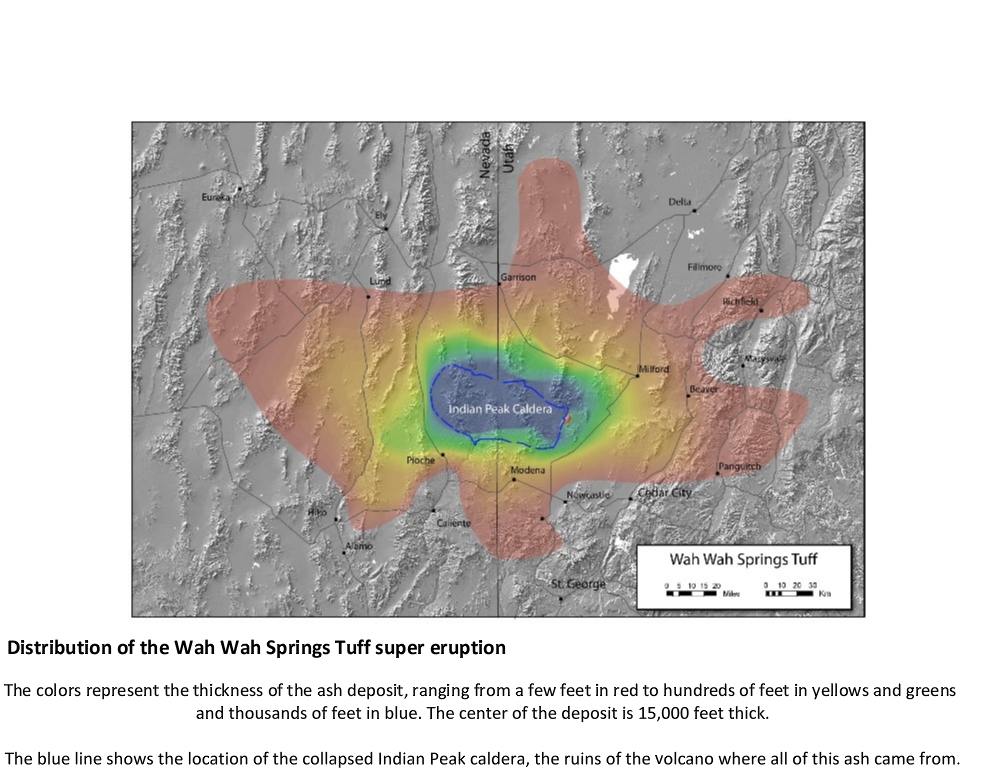Post by 1dave on Apr 8, 2015 16:05:40 GMT -5
BYU geologists discover ancient ‘supervolcano’ eruptions in Utah, Nevada

However, it adds confusion to the Ajax Impact Crater.

ST. GEORGE - A research team led by geologists from Brigham Young University has discovered the remains of 17 supervolcanoes in southwestern Utah and southern Nevada that erupted, according to their appraisal, about 30 million years ago. These eruptions are among the largest known volcanic events worldwide and greatly impacted the area’s geologic history.
. . .
The Wah Wah Springs tuff is home to a group of 17 ancient volcanoes so big they are classified as “supervolcanoes.” Volcanic events in recorded history, among the most devastating being the 1883 eruption of Krakatoa and the 1815 eruption of Mount Tambora, are dwarfed by the magnitude of these explosions, which occurred mostly before the existence of human beings. Also unlike modern volcanoes, supervolcanoes typically collapse into themselves after an eruption, leaving behind a massive crater known as a caldera rather than a peak.
...
The largest volcano on the tuff is the Indian Peak Caldera, approximately 35 miles wide and 3 miles deep. It is one of the biggest supervolcanoes ever discovered, and findings suggest that it erupted several times.
One explosion was among the largest known volcanic events, discharging more than 5,500 cubic kilometers of magma over a week. This eruption was about 5,000 times more powerful than the catastrophic 1980 Mount St. Helens eruption and left a significant part of Utah and Nevada buried in ash more than 1,000 feet thick, with traces found as far away as Nebraska.
. . .
The staggering size of Indian Peak and neighboring calderas are comparable only to the well-known craters of Yellowstone. But unlike those volcanoes, they are not active and will never experience another eruption.
. . .
The Wah Wah Springs tuff is home to a group of 17 ancient volcanoes so big they are classified as “supervolcanoes.” Volcanic events in recorded history, among the most devastating being the 1883 eruption of Krakatoa and the 1815 eruption of Mount Tambora, are dwarfed by the magnitude of these explosions, which occurred mostly before the existence of human beings. Also unlike modern volcanoes, supervolcanoes typically collapse into themselves after an eruption, leaving behind a massive crater known as a caldera rather than a peak.
...
The largest volcano on the tuff is the Indian Peak Caldera, approximately 35 miles wide and 3 miles deep. It is one of the biggest supervolcanoes ever discovered, and findings suggest that it erupted several times.
One explosion was among the largest known volcanic events, discharging more than 5,500 cubic kilometers of magma over a week. This eruption was about 5,000 times more powerful than the catastrophic 1980 Mount St. Helens eruption and left a significant part of Utah and Nevada buried in ash more than 1,000 feet thick, with traces found as far away as Nebraska.
. . .
The staggering size of Indian Peak and neighboring calderas are comparable only to the well-known craters of Yellowstone. But unlike those volcanoes, they are not active and will never experience another eruption.
However, it adds confusion to the Ajax Impact Crater.














